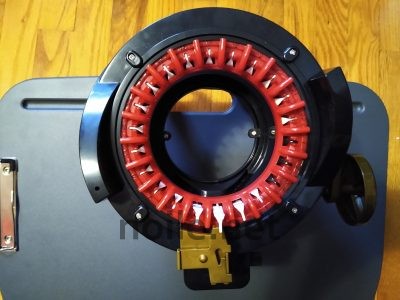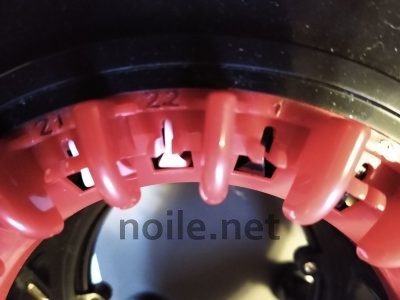Years ago, Mr. Noile and I saw a demonstration of a vintage circular sock loom at a crafts exhibit, and we kind of fell in love with the idea of using an ancient device to make something at once so practical and so luxurious.

We soon learned that sock looms — the metal, ancient, venerable kind — are pricey, and that they can be a tricky item for a novice to buy. And that vendors tend to have lengthy waiting lists for the few that become available. So we let the idea simmer. Until now, when I wanted something new to learn to wrap up the year.
Somehow I found out about a much less expensive German loom, and this winter I began researching the whole idea of using a smallish circular loom at home. Much to my surprise, I learned that there are actually a lot of hobby circular looms around, many of which are less expensive than the one I ended up buying.
The less expensive ones have pretty dismal reviews, with breakage apparently the biggest issue. But the information I turned up suggested that an Addi Express was likely to meet my requirements — and at a price, while higher than the craft store looms, was still many hundreds of dollars less than an elusive vintage model.
TLDR: I like my Addi a lot. But since I wasn’t interested in doing flat knitting, and, in fact, wanted specifically to make socks. The learning curve turned out to be steep, even though my initial goal was simple: I want to make bed socks, and I wanted them to fit. I don’t have any trouble finding all weights of socks to wear in various shoes and boots, but it’s always been nearly impossible to find socks for my iceberg feet that are both loose enough to be comfortable to wear in bed, and snug enough to stay on all night.
I’ll be posting about my [mis]adventures with the Addi, but first here are a few useful tips for working with it:
1. The best kept secret on an Addi is that the needles are numbered. The bad news is that the numbers are almost invisible. Being able to identify each needle by number is hugely useful; the first thing you should do before you start working on your machine is to take a fine point permanent marker and make those numbers visible. Unless you’re paying attention to the needle numbers, it’s very difficult to keep accurate track of where you are on the loom. More on this later.
 Even with highlighting, it can be difficult to make the numbers out easily.
Even with highlighting, it can be difficult to make the numbers out easily.
But it’s a whole lot easier than leaving them the same color as the background.
2. Research before you buy yarn. Yarn matters! It needs to be thick enough for the machine, but not too thick, and it needs to have a lot of integrity. That is, it better not fuzz or split. I read a lot of dubious recommendations on the internet, but the best advice was at Kelsey Jane Designs. Her list of the ten best and ten worst yarns for the Addi is excellent. Spoiler: you may have have to forgo wool, at least as a beginner. (Though I’ve since found wools that work.)
3. Tension matters more than anything! Not yours, while learning, but how you hold the feed yarn. It must be both firm and light. Nearly every disaster you’ll have will be down to poor tension. The good news: it’s easy to get it right, even if it’s difficult to remember that it matters for every stitch. A $500 (USD) vintage sock machine has a built-in tensioning device; your considerably less expensive Addi only has you.
4. This is mentioned nearly nowhere, but a critical component of sock-making success is ensuring that every yarn strand, for every stitch, goes all the way under the curved red vanes. The vanes are between every needle, and they are your best friend. Neglect them at your peril.
5. If, like me, you want to do entire socks on your Addi, without any knitting — personally, my hands just don’t work well enough any longer for knitting, and haven’t for years — prepare for failure. Lots and lots of failure. Mr. Noile observed me struggling — there might have been sighs and there might even have been (cough) language, at times — and reminded me that players of the Chinese game Go are advised to lose their first 100 games as quickly as possible on their path to proficiency.

I’m writing this just after having completed my first 49 failures on the Addi. Not whole sock failures, mind you, but failures of bits and pieces of every kind as I doggedly straggled toward sock glory.
More to follow — only 51 more failures to go! (Note: not exactly — I’m posting this after my 86th casting on, and after making several successful pairs of socks! More Addi posts to follow. I’m loving this little machine!
